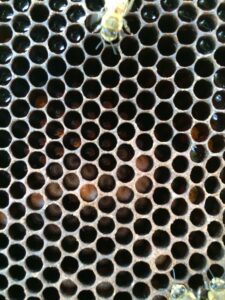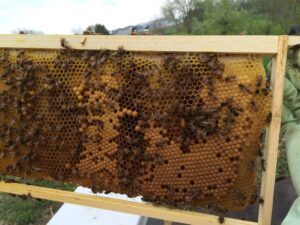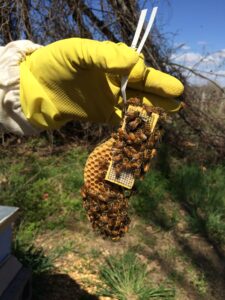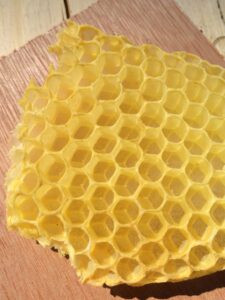In the bee-ginner classes I taught this year, I said I’d be posting periodic updates of my packages’ and nucs’ progress, so you could compare and ponder whether yours were ahead or behind or what.
Typically packages arrive within a few weeks of each other, and typically nucs arrive about a month later. Not this year. Some of you installed packages and nucs three weeks ago. Some of us aren’t getting our packages until mid-May, due to inclement weather in the south. It won’t be useful to say “here’s what likely is going on” – because a five-week difference in a new colony is substantial.
A year ago I posted about-weekly updates on what to look for when, and things to do. You could reference those blogs for some details. While I’ll strive to do something similar, I don’t have a package installed yet to report on, so I’ll be writing in generalities.
A Package Installation Tip
We helped some newbees install recently, and tried the method found in a video on Napoleon Bee Supply’s FB page. The method uses two boxes. The queen in her cage is secured in the bottom box, toward the top of a frame in the middle. A second, frameless box goes on top.
The shipping box (with the approximately 10,000 bees) can be laid on its side in the upper box, or even turned upside down with the hole over the queen cage. The newbees we helped did it both ways and it worked out fine. The bees clamored down into the frames and surrounded the queen cage. Removal of the shipping box, and the top hive body a day later was easy.
This isn’t the method I taught, and I didn’t want to recommend it until I tried it. It worked just fine!
Queen Release Tip (Major Uh-oh!)
I’ve installed probably 150 packages over the years. And this major uh-oh has happened twice now.
The major uh-oh is that when we released the queen, she flew away instead of scampering into the frames. So—there’s something to be said for NOT using the “direct release of the queen” method that I recommended, and instead using the “eat their way to her” method! A queen flying away is rare, but it happens.
Somewhere in SW Michigan is a queen without a colony.
I still prefer the direct release method, but think I would’ve left the second (top) box on when I released her. I’d removed it first, and that was a lot of “openness” for her to experience.
Anyway, if you see a queen wandering around, please send her back, thanks.
The Most Important Thing
Regardless of when you installed, and whether it was a nuc or a package, the most important thing to check for during about the first ten days, and then every time you are in the hive after that is whether or not they are queenright.
A queenright colony has a queen who is laying predominantly worker brood.
Finding a queen doesn’t ensure you are queenright—she might not be laying, or might not be laying worker bees.
Look for a single egg / cell.
If you can’t see eggs (and they are difficult to see!) look for larva. That tells you there was a queen at least within the last three days.

After three days, an egg turns into a worm. They may be seen more easily than an egg, especially as they get larger and curl up in the bottom, looking like a small white grub.
No larva? Do you have capped brood? That tells you there was a queen within the last eight days. Is it drone capped brood, or a mix? It needs to be predominantly worker brood.

See the queen? She’s fairly easy to spot in this photo. Most of this capped brood is worker brood, but the half dozen or so protruding a bit more is drone brood.
No queen, eggs, larva or worker capped brood? There may be problems. Talk to your mentor or another experienced beekeeper.
Other Helpful Hints
Feeding: You’ve invested a lot of money in these stinging insects. I’d keep feeding 1:1 sugar syrup as long as they’re taking it. They’ll stop when there is enough fresh stuff available and the weather is appropriate. Why not help them get off to as good a start as possible?
Too many boxes: Some of the newbees we’ve been working with have all their hive bodies on. You want to add boxes only as needed. Too much room and the bees can’t keep it warm, effectively patrol against predators and parasites, etc.
Questions? Comments? Contact me if I can help.
And remember, this is all just one beekeeper’s opinion and experience. There are multiple ways to skin most cats.


